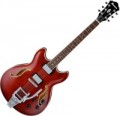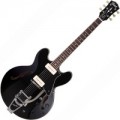Nut width
The width of the fretboard of an electric guitar at the nut. Closer to the body, the neck may expand somewhat, but this is not necessary, and the expansion angle may be different. Therefore, the main size is considered to be the width in the region of the nut.
This parameter has two meanings. On the one hand, a wide neck is inconvenient for musicians with small hands and short fingers — it can be difficult to reach the far strings in such cases. On the other hand, a larger width means a greater distance between the individual strings, which reduces the likelihood of hitting an adjacent string when pressed incorrectly and can make playing easier (especially if the guitarist has large fat fingers). However, these moments are not absolute, and the convenience of playing is a very subjective matter, depending on many features of the musician and the technique he uses. Also, don't forget that necks can have different profiles (see above), and instruments with different neck profiles will feel differently in the hands even with the same width at the nut. Therefore, the most reliable method of selection is to try out the necks of different sizes and profiles “live”, decide on the best option and choose based on this.
The smallest neck width at the nut in modern electric guitars is about 39 mm. This size is found mainly in bass guitars (see “Type”), which have 4 strings and a neck that widens noticeably towards the body (due to which it can be made rather narr...ow from above, especially since when playing bass, notes are rarely clamped near the neck itself) . Electric guitars (including semi-acoustic) are somewhat wider — from 41 mm, an indicator of 43 – 48 mm is considered average, and in the largest instruments, the neck can be up to 55 mm wide (however, such dimensions are typical mainly for instruments with more than 6 strings) .
Scale
The scale is the distance from the nut to the bridge; in other words, this is the working length of the open (not pressed with a finger) string. The greater this distance, the more tightly the strings must be stretched to achieve the desired pitch and the greater the force required to press them against the fingerboard. However, some guitarists argue that even a small difference in length - less than an inch - already makes a significant difference in the feel when playing.
In addition, this parameter also affects the color of the sound. A longer length allows you to get a brighter, louder and more expressive sound, while a shorter length allows you to get a denser, “warmer” and smoother sound. Thus, all other things being equal, a relatively short scale length is better for playing chords, while a longer instrument may be needed to achieve the desired sound in a solo.
The most popular scale length options in electric guitars (not basses) are
24.75" (Gibson) and
25.5" (Fender). Indicators less than 22" are extremely rare, mainly in instruments with miniature 3/4" bodies (see "Size"), and the maximum value is about 28", longer instruments are practically not produced. But basses have a noticeably longer length ( otherwise the strings for them would have to be made too thick or tensioned too loosely): the shortest models provide a scale length of 30", but the classic value is
34".
Note that the design of the bridge often allows you to change the actual scale length (including for each string separately); This is done to ensure that the instrument plays accurately along the frets. Therefore, in the characteristics it is customary to indicate the default scale length, without additional adjustments.
Neck material
The material from which the neck of an electric guitar is made.
The most commonly used in the manufacture of the neck is
mahogany.
and
maple. Theoretically, the acoustic properties of an instrument are determined by all its details, and even more so, these properties are affected by the quality of the fretboard. At the same time, we note that this influence is not so strong compared to other characteristics of the guitar (type and number of pickups, scale size, body type, etc.). So in this case, it makes no sense to describe in detail each type of material found in modern instruments — especially since the same term (for example, “mahogany”) can denote different types of wood that differ markedly in working properties and overall quality. When evaluating the material of the neck, it is quite possible to proceed from the fact that the manufacturer selects it in accordance with the price category and the general specialization of the guitar.
Case
The presence of a
case or cover included with the guitar.
Both the case and the case are tool cases, with the difference that cases are made of hard materials and provide better impact protection, while soft cases are more convenient to transport (especially on the shoulders). Anyway, the case is highly desirable for storing and carrying the instrument. It at least protects the guitar from dirt, moisture, temperature extremes, shocks and other adverse effects, and when carrying it, it also provides additional convenience: the design has appropriate devices for this, such as handles or straps. In addition, cases and covers often have additional compartments for accessories (spare strings, picks, notebooks, pedals, etc.)
The presence of a case in the kit saves the musician from having to buy it separately — especially since such an accessory is optimally suited to the "native" model of the guitar. The latter is especially important for custom-shaped cases, for which it can be very difficult to find separately sold cases. At the same time, complete cases / covers may not provide the required degree of protection — often these are the simplest products, designed mainly for warm weather without precipitation. So the characteristics of the complete case will not hurt to clarify separately.

